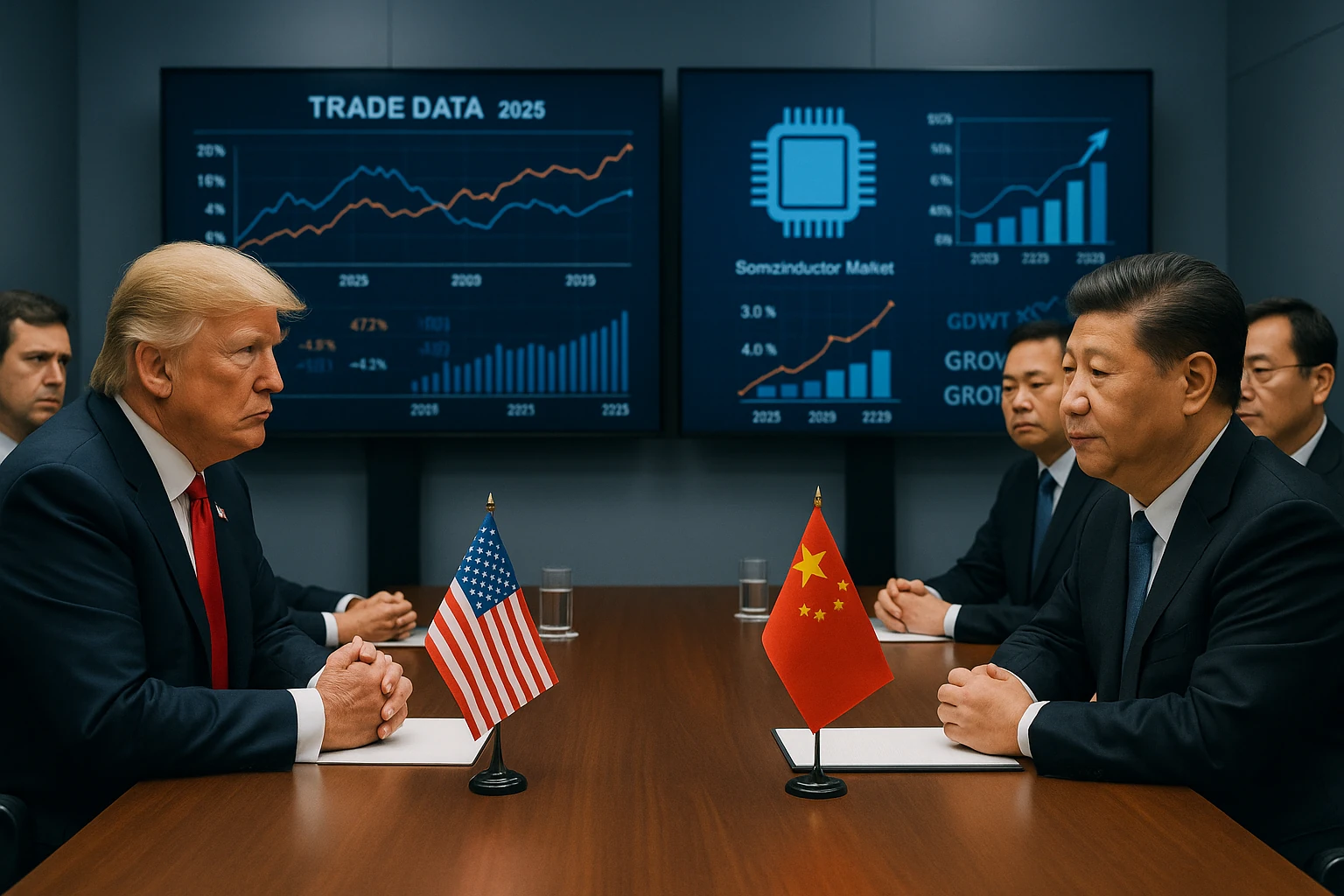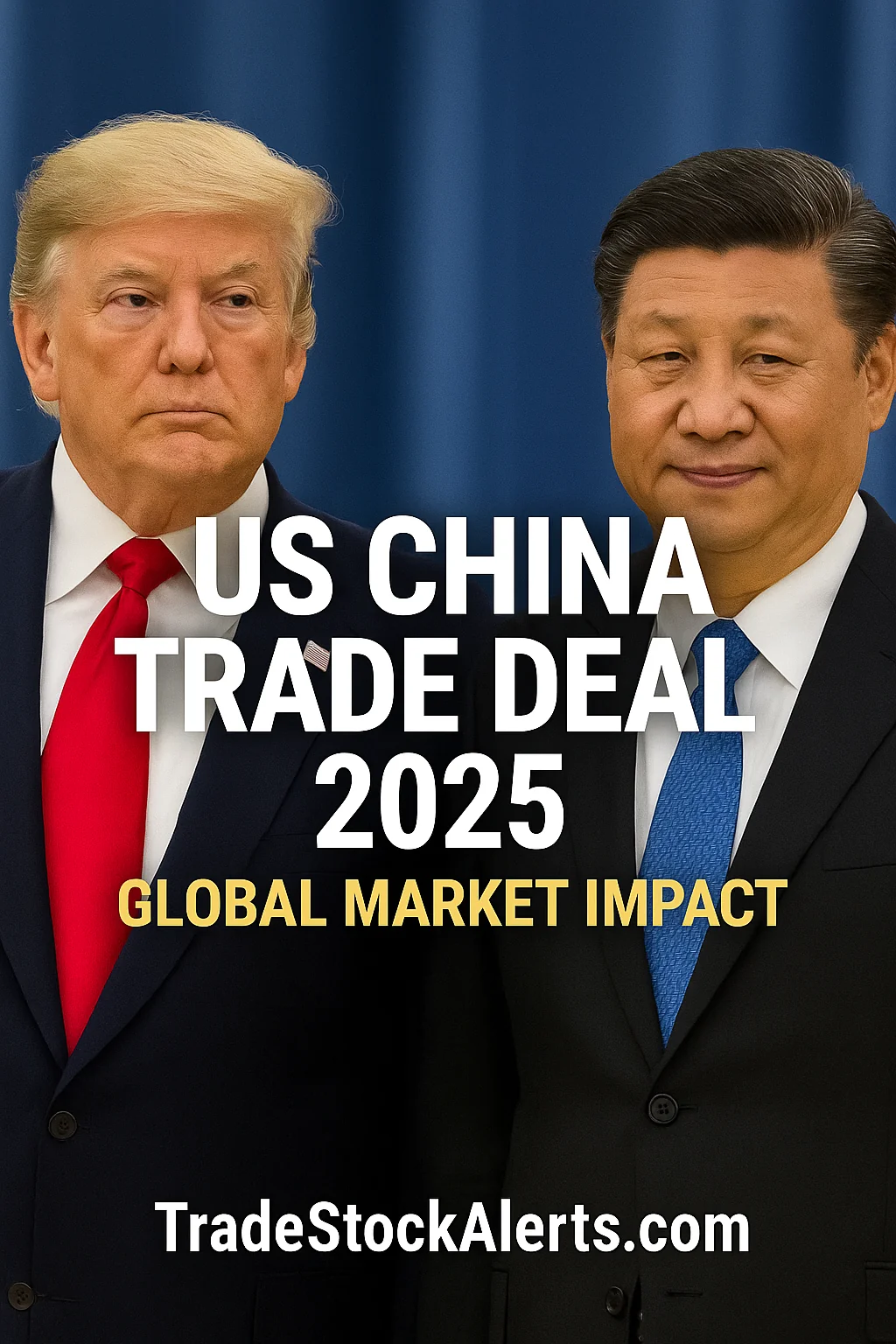
US and China Trade Deal 2025 — What This ‘Substantial Framework’ Could Mean for Global Markets
Global markets are buzzing after Washington and Beijing unveiled what both sides are calling a “substantial trade framework” for 2025. This landmark update follows years of friction, tariffs, and uncertainty that rattled tech exports, manufacturing output, and global supply chains. As the world’s two largest economies look to rebuild economic cooperation, traders and investors are asking what the US China trade deal 2025 could mean for equities, commodities, and emerging market flows in the months ahead.
Market sentiment has improved since the deal’s announcement, with investors betting on renewed trade stability and smoother global supply chain recovery. Technology exporters, EV suppliers, and commodity producers stand among the top beneficiaries—each positioned to gain from lower tariffs and fresh export opportunities. But behind the optimism, analysts are closely watching for the fine print on enforcement and data transparency that could make or break this fragile peace.
📊 Key Points
- 🤝 Substantial framework: The new deal signals easing tensions and renewed cooperation after years of tariff battles.
- ⚙️ Supply chain reset: Manufacturing and shipping hubs across Asia are preparing for stronger trade volumes in 2025.
- 💻 Tech and exports: Semiconductor and EV component suppliers could see outsized gains as cross-border trade improves.
- 🌍 Emerging markets boost: Stabilized trade may attract foreign capital back into growth economies by late 2025.
- 📈 Investor focus: Stay tuned to Reuters China updates for tariff timelines, policy clarifications, and market reactions.
Global Market Reaction: From Trade Tensions to Tentative Optimism 🌏
Financial markets responded swiftly to news of the US China trade deal 2025, with Asian equities rallying and U.S. futures turning higher in premarket trading. Investors interpret the framework as a stabilizing step that could restore confidence after years of tariffs, sanctions, and fragmented trade policies. Sectors tied to manufacturing, logistics, and consumer goods saw immediate inflows, while technology shares benefited from expectations of renewed semiconductor demand.
The Shanghai Composite climbed nearly 3% in early trading, and the Hang Seng Index posted its strongest single-day gain in over a year. On Wall Street, futures tied to the Nasdaq surged as investors priced in better access to Chinese supply chains and easing restrictions on sensitive technology exports. Analysts at Bloomberg reported that both U.S. and Chinese negotiators described the pact as a “living agreement,” meaning that new digital trade and AI clauses could be added over time.
USD/CNH chart — a key currency pair often viewed as a barometer for trade tensions and capital flow expectations.
A Turning Point for the Global Supply Chain?
The trade pact introduces a phased reduction of tariffs on semiconductors, electric vehicles, and select agricultural goods. Logistics companies are reporting increased inquiries for cross-border shipping contracts, suggesting that a rebound in global trade volumes may be underway. According to Reuters China, the framework also includes a digital commerce clause covering data flow and cybersecurity standards—an area of friction that previously derailed multiple rounds of talks.
For global investors, this shift could improve supply predictability and lower input costs for manufacturers. It may also ease inflationary pressures by reopening trade routes previously constrained by tariffs and geopolitical risks. As optimism grows, funds tracking world markets have already seen notable inflows, indicating that capital rotation toward trade-sensitive sectors is gaining momentum.
Tech & Export Impacts: Semis, EV Supply Chains, and Data Rules
At the center of the US China trade deal 2025 are provisions aimed at reducing friction in high-value supply chains: semiconductors, EV components, and advanced manufacturing equipment. A phased rollback of selective tariffs, clearer export-control guidance, and a draft rulebook for digital trade (data flows, audits, cybersecurity) could unlock deferred capex and re-route orders that have been sitting on the sidelines since the last escalation. Net effect: improved visibility for OEMs and component suppliers, plus tighter basis spreads for logistics and distributors.

Semiconductors & Advanced Manufacturing
- Tariff relief & licensing clarity: Eases order backlogs for tooling and specialty materials.
- Visibility for foundries/OSAT: More predictable lead times and capacity planning.
- Risk: Any ambiguity on advanced node restrictions could cap upside for the highest-end chips.
EV & Battery Supply Chains
- Component flows: Cathodes, anodes, and power electronics benefit from clearer customs rules.
- Critical metals link: See our critical metals EV guide for sourcing exposure.
- Risk: Rules-of-origin and subsidy eligibility remain swing factors for OEM margins.
Policy watch: Draft clauses around data localization, cross-border audits, and cybersecurity could determine how quickly cloud, AI, and industrial IoT projects scale under the framework. For day-to-day developments, monitor Bloomberg trade coverage, Reuters China, and MarketWatch politics & economy.
Strategy Pointers for Traders & Investors
- Momentum vs. mean reversion: Track tech/export indices versus USD/CNH—a weaker USD/CNH often supports risk appetite.
- Hedge with commodities: If trade volume rebounds, industrial metals and silver can tighten; review our silver rally strategy.
- Diversify cross-asset risk: Blend equity bets with non-correlated sleeves; see our diversified crypto & metals guide.
Global Supply Chain Recovery: Freight, Commodities, and Trade Corridors 🚢
The US China trade deal 2025 is reshaping how goods move across the Pacific. After years of volatility, shipping rates, container availability, and port congestion metrics are beginning to normalize. The framework includes new logistics transparency measures—digital customs forms, cargo-tracking APIs, and data-sharing protocols—intended to reduce transit delays by up to 25% between the U.S. West Coast and key Asian hubs.
According to Reuters China, trade officials are piloting a “Green Lane” program for low-carbon and high-tech exports to streamline customs clearance. Early participants include EV component suppliers, agricultural processors, and medical-device exporters—each benefitting from reduced regulatory friction. These improvements could ripple through shipping and commodity markets, aligning with forecasts from MarketWatch’s economy reports showing a gradual rebound in trade-linked GDP contributions by mid-2026.
The Baltic Dry Index (BDI) is a key indicator for global freight trends, reflecting changes in shipping demand and trade volume.
Commodity Markets Signal Stabilization
Freight normalization has a direct impact on raw material pricing. When logistics costs ease, producers and traders can move commodities faster, helping stabilize the prices of metals, grains, and industrial inputs. Analysts at Bloomberg Trade note that this shift coincides with a broader uptick in commodity futures—particularly copper, silver, and nickel— each benefitting from improving industrial orders and renewed EV demand.
These factors have also contributed to stronger performances in logistics ETFs and emerging-market equity funds. Investors focusing on diversification can take cues from diversified crypto and metals portfolios, which tend to benefit from synchronized commodity cycles and trade reopenings.
2025–2026 Outlook: Where Capital Could Flow If the Deal Holds
If the US China trade deal 2025 translates from headline to policy, three channels stand out for investors: (1) trade-sensitive tech and manufacturing, (2) logistics and shipping, and (3) resource assets tied to EV and infrastructure cycles. Stabilized tariff schedules, clearer data rules, and normalized freight can lift earnings visibility and compress risk premiums— conditions that typically favor a rotation into cyclicals and select emerging markets.

1) Tech & Advanced Manufacturing
- Earnings drivers: Tariff clarity, improved lead times, revived export orders.
- Watch: USD/CNH trend, export-control guidance, foundry/node disclosures.
- Risk: Policy reversals or stricter licensing on advanced nodes.
2) Logistics, Shipping & Ports
- Earnings drivers: Higher volumes, steadier contract rates, lower dwell times.
- Watch: Baltic Dry Index (BDI), container rates, port throughput updates.
- Risk: New chokepoints or fuel/insurance spikes that re-inflate costs.
3) Resources & EV Supply Chain
- Earnings drivers: Reacceleration in metals demand (Cu, Ni, Ag) and battery components.
- Deep dive: See our critical metals EV guide and silver rally strategy.
- Risk: Commodity volatility, subsidy/Rules-of-Origin changes, geopolitical flare-ups.
| Scenario | Policy Path | Likely Winners | Key Risks |
|---|---|---|---|
| Bull: Deal cements | Tariffs phased down; data rules finalized; freight normalizes | Tech/export cyclicals, logistics, EM equities, EV metals | Overheating, capacity bottlenecks, sharp USD rally |
| Base: Stop-start | Mixed enforcement; incremental tariff relief | Selective cyclicals; quality EM; diversified resource plays | Headline risk, supply noise, uneven demand |
| Bear: Re-flare | Talks stall; controls tighten; freight costs re-spike | Defensives, domestic services, high-quality cash generators | Tariff snapbacks, sanctions, FX volatility |
Portfolio Tip: Blend cyclicals with non-correlated sleeves to manage policy risk. Consider a metals hedge (see our diversified crypto & metals guide) alongside tech/export exposure. Use USD/CNH and freight indices as confirmation signals before sizing up.
FAQs: Understanding the US–China Trade Deal 2025
What is included in the 2025 US–China trade deal?
The 2025 agreement introduces a “substantial framework” that covers tariff adjustments, technology licensing, digital commerce, and logistics transparency. It aims to balance trade access between both nations and rebuild trust after years of tariff escalations. The deal is being rolled out in phases, with enforcement and audit mechanisms expected to follow later in the year.
How does this deal affect technology and manufacturing sectors?
Lower tariffs and clearer export rules help semiconductor and EV companies regain supply stability. The deal’s digital trade clause encourages secure data sharing between U.S. and Chinese firms, improving visibility across manufacturing and logistics operations worldwide.
Will global supply chains finally stabilize in 2025?
Signs are positive. Freight rates are easing, shipping delays are down, and container utilization is improving. According to Reuters, new digital-trade measures could cut processing times by as much as 25%—a significant efficiency boost for importers and exporters alike.
What are the biggest risks to the 2025 deal?
The main risks include policy reversals, enforcement delays, or geopolitical tensions that could derail progress. Sudden restrictions on sensitive technologies or renewed tariff disputes could reintroduce volatility into trade-linked markets.
How can investors position around the deal?
Traders can use a cross-asset approach—combining exposure to trade-sensitive equities, metals, and shipping indices. Those seeking diversification can explore our guides on silver trading strategies and diversified crypto & metals portfolios for inflation-hedged growth opportunities.
Conclusion: A Trade Truce with Global Ripple Effects 🌐
The US China trade deal 2025 signals a long-awaited reset for two economies that together drive more than 40% of global GDP. By easing tariffs, reestablishing dialogue, and modernizing data regulations, the framework lays the groundwork for renewed industrial cooperation and global growth. Whether this détente becomes durable policy or just a temporary ceasefire will depend on enforcement transparency and geopolitical restraint in the months ahead.
For traders and investors, the key is agility—staying alert to policy signals, currency shifts, and freight trends. Those positioned across commodities, tech, and logistics may find that this new chapter in U.S.–China relations offers not just headlines, but genuine market opportunity.

Pauline Lei
Global trade and market analyst at TradeStockAlerts.com. Pauline tracks geopolitical and economic developments that shape market cycles—especially U.S.–China relations, supply chain dynamics, and emerging-market trends. Her insights help investors connect the dots between trade policy, technology exports, and commodity flows, turning major global agreements like the US–China Trade Deal 2025 into practical strategies for traders and long-term investors alike.